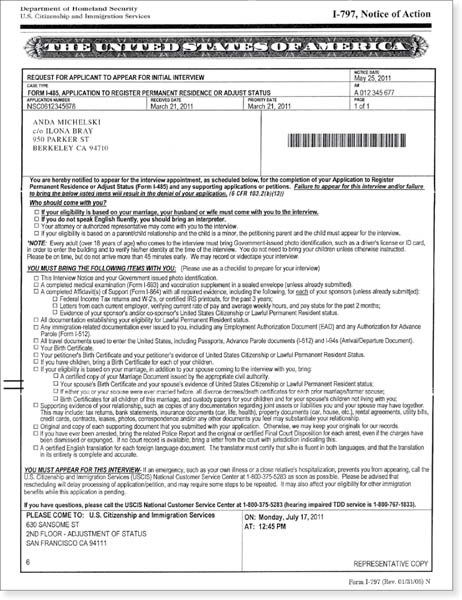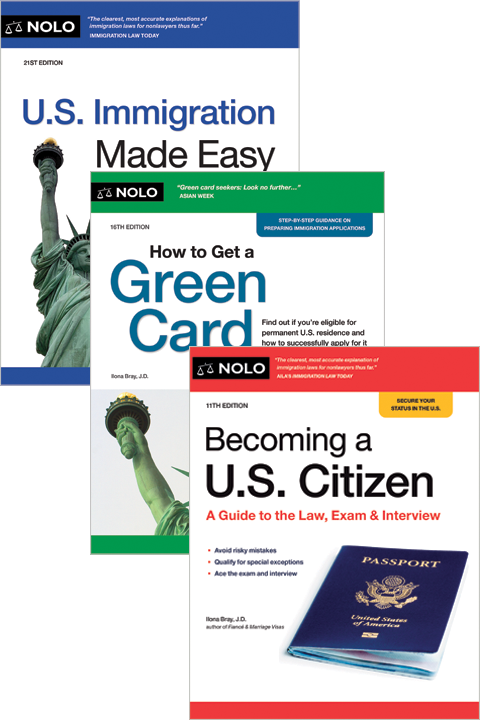A step-by-step description of what will happen at your marriage-based green card interview with USCIS.
If you have applied for a green card based on marriage, and are eligible to do your entire application process in the U.S. ("adjust status"), then a few months after submitting your I-485 adjustment of status (AOS) packet to U.S. Citizenship and Immigration Services (USCIS), the agency will most likely schedule you for an interview. This will be held at one of its local offices, hopefully near where you live.
If the AOS interview goes well—your marriage is obviously the real thing, you do not fall into any of the grounds for inadmissibility, and your documents are in order—the interview can take as little as 20 minutes, and result in approval for a green card. You will either be approved for permanent residence or, if you have been married for less than two years or entered the U.S. on a K-1 fiancé visa, what's called conditional residence (which expires in two years unless you take steps to convert it to permanent residency).
WARNING: ICE has been making an increasing number of arrests at AOS interview. In past years, after applying to adjust status, applicants were normally recognized as being in lawful immigration status and could comfortably wait until the interview and eventual approval. Owing to Trump Administration heightened enforcement priorities, however, people attending adjustment interviews are newly at risk. It's not a consistent practice or pattern, but attorneys have noted that the applicants seemingly most at risk are those who either:
- entered the U.S. without inspection (illegally)
- fell out of lawful immigration status while awaiting their AOS interview (in other words, their permitted stay expired or ended), or
- claim to have entered the U.S. lawfully because they were "waved through" at a border point though they received no actual I-94 or other documentation.
That's in addition to people who were already considered legitimate targets for arrest, because they had serious crimes or security violations on record, or had already been ordered removed. If you fit any of these criteria, or otherwise have reason for concern, consult an immigration attorney.
What Does the AOS Interview Notice Look Like?
The appointment notice will look much like the one below. Read the notice carefully. Your local USCIS office might have added new or different requirements.
Step-by-Step Outline of Adjustment of Status Interview
Here's what will probably happen at your adjustment of status interview, step by step.
1. After arriving at the USCIS office, you will need to pass through a security checkpoint and metal detector. The guards will ask to see your USCIS appointment notice. You will not be allowed to bring weapons, food, or drink into the building. The building might have its own rules prohibiting other items.
2. After sitting in the waiting room for so long that you're sure you have been long forgotten, you will be summoned to the inner rooms of the USCIS adjustments unit.
3. The USCIS officer will lead you to their desk and check your identification. Just when you are seated comfortably, you, your spouse, and your foreign language interpreter (if you have brought one) will have to stand up again, raise your right hands, and take oaths to tell the truth.
4. The USCIS officer will ask to see all of the immigrating family's passports and travel documents (such as Advance Parole), work permits (if any), Social Security cards (if any), and driver's licenses (if any). The officer might also want to see documents from the petitioning spouse, such as a driver's license, Social Security card (if available), and proof of legal U.S. immigration status (such as a green card or U.S. passport). In addition, the USCIS officer will want to see any documents updating the application; for example, a birth certificate for a new baby, an employer letter for a new job, or an arrest record if the immigrant has had a run-in with police (in which case you'll need an attorney's help with your case).
5. The USCIS officer will start by going through the written application for adjustment of status, asking about the facts and examining the medical and biometrics (fingerprint) reports for factors that might make you ineligible for a green card. This is one of the most important parts of the interview. In fact, under the Trump Administration, officers are encouraged to ask every question on your Form I-485 application. (Review it beforehand!) You will sign the application to confirm its correctness.
6. The USCIS officer will ask you and your spouse about your married life, such as where you met, when and why you decided to get married, how many people attended your wedding, or what you did on your most recent holiday celebration. You will back up your answers with documents showing the genuine nature of your marriage, such as mortgage or rental agreements, joint credit cards, and joint utility bills.
7. An officer who spots a problem in your application that you can correct by submitting additional materials will likely put your case on hold and send you home with a list of documents to send in by mail within a specified time. For example, if your spouse's earnings are insufficient to get past the 125% of the U.S. Poverty Guidelines required in most cases, the officer might suggest you find another family member to sign an Affidavit of Support. It's rare for USCIS to deny an application on the spot.
8. If the officer suspects that your marriage is fraudulent, however—just a sham to get you a green card—the officer will add a whole new step to the process. You will have to meet the Fraud Unit, and do a "Stokes interview." There, officers will interview you and your spouse separately and intensively, asking mostly the same questions of each of you. The officer will compare the results of your two interviews.
Which Couples Get Called in for Marriage-Fraud Interviews?
As mentioned above, some couples whose personal characteristics or living situations raise red flags in the eyes of USCIS might have to go through not only a regular interview, but also a "fraud interview" (also called a "Stokes interview").
USCIS is on the lookout for couples who, for example, do not seem to share a common language; have large differences in their age, religion, class, cultural, or educational background; or do not live together, at the same address. It's not only the couples faking a marriage who get called in for these!
What Happens at the End of an AOS Interview
At the end of the adjustment of status interview, you might be told that everything looks good and that you will be approved for lawful permanent residence (sometimes after a supervisor agrees). Several weeks later, your actual green card should arrive by mail.
If you are denied, the normal procedure is for the USCIS officer to advise you of this fact and send you home; though with the possibility that, if you had no separate right to remain in the United States, you'd receive a Notice to Appear (NTA) later, scheduling you for a removal hearing in immigration court. Again, however, there's an increased (though not huge) chance that the interviewee will be arrested on the spot.
If you receive conditional rather than permanent residence (because your marriage is relatively new), you will have to file an application about 21 months from your approval date in order to progress to permanent residency.
Getting Legal Help
For personalized assistance with applying for lawful permanent residence based on marriage to a U.S. citizen or green card holder, consult an experienced attorney. The attorney can review your immigration history and alert you to any problems, and accompany you to the interview, which can help to avoid misunderstandings, legal and otherwise. Even if you don't hire an attorney, be sure to let family members know you'll be going to the interview, and memorize their phone numbers, in case the worst happens.
Talk to a Lawyer
Need a lawyer? Start here.
How it Works
- Briefly tell us about your case
- Provide your contact information
- Choose attorneys to contact you
- Briefly tell us about your case
- Provide your contact information
- Choose attorneys to contact you


